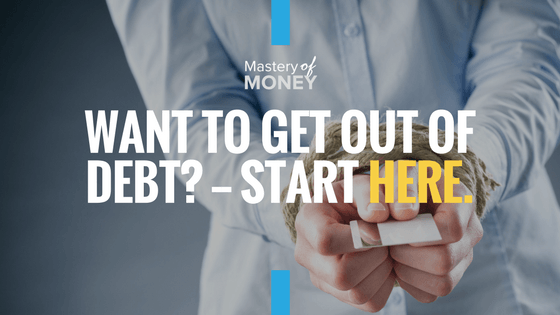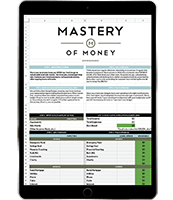At the age of 23 I was struggling under the pressure of nearly $50,000 in debt between student loans, credit cards, a car loan, and a variety of consumer debts. I remember putting purchases on my already-ballooning credit cards and rationalizing, “if I charge this, then I’ll have cash in my checking account.”
My money programming was completely jacked.
Looking back, I know exactly why and how it happened. My college career was one long social experiment. My Dad called it my ‘4-year break from reality’. I called it the longest and most expensive party I’ve ever been to.
In the first few months of my freshman year, I signed up for a credit card through MBNA in exchange for a 2 pound bag of M&M’s and a seemingly unending source of fun (and ultimately, frustration).
Upon graduation, I left my University with a healthy $8,000 in credit card debt at nearly 25% interest. (Almost all of it was spent at a place called Shagnasty’s. *true story*).
Within four years I was completely debt free with the exception of a mortgage. For the past decade, my wife and I have lived a life of freedom and flexibility having now amassed a high 6 figure net worth. I want to share with you how to do it yourself…
What got you here, won’t get you there.
You Can Break Free
This post is for anyone that wants (as desperately as I did) to break free from the bonds of debt. It is entirely possible to radically shred your debt faster than you can currently imagine and this post will show you how. Whether you’re drowning in student loan debt, buckling under credit card debt, or just want to eliminate your mortgage, you’ll be shown how to do exactly that.
Throughout the next few paragraphs, I’ll share the exact steps to take to begin eliminating the debts one by one. Use this as a guide, of sorts, to navigate the turbulent waters of debt elimination. I say they’re turbulent because this is a somewhat emotional process to go through. Just know I’m here for you, as is the Money Savvy Community online.
I heard someone say once, “You can’t borrow your way out of a spending problem.” It was the beginning of my awakening that my problem was two-fold — not enough income and too many expenses. At the time I had more control over one than I did the other, and that’s where we’ll begin.
Build A Bigger Life, Not A Bigger Lifestyle
In working with individuals, couples and families, I’ve noticed that those who are generally the most indebted are also the ones who have built a lifestyle that they can both not entirely afford and seemingly can’t live without.
Take a client of mine who has high six figures in student loan debt. She makes no where close to what she should with the degree she’s obtained, worries daily about her debt, yet in one month spent almost double what she told me she’d “budgeted” for groceries and dining out.
Another client had mounting credit card bills, yet spent over $200 a month on his cable TV subscription which was costing him both in wasted time AND added expense. He would spend his evenings and weekends plowing through his “full DVR” and gripe about debt when we talked once a week.
I’m always amazed when someone tells me after buying or leasing a new car with significant payments, “well I needed something reliable.” As if reliability trumps cost, monthly expense, or common sense!
Speaking from experience, if you invest two years in building a bigger life instead of a bigger lifestyle, you’ll be able to afford the lifestyle of your dreams in no time. One of the keys is identifying where you’re spending and where you can cut back.
STEP ONE: What’s Coming In, What’s Going Out?
Let’s get this out of the way — budgets suck. And every single financial guru out there will tell you that you need to live by one. Especially if you’re feeling like the captain of the Titanic.
With all of the budgeting tools out there, there is one that I think is by-far the easiest, most comprehensive, and simplest to test drive. It’s called Personal Capital and it will help you give every dollar a job, age your money, and embrace your true expenses.
Step One in getting out of debt is knowing what’s coming in and what’s going out. By clicking on this link HERE, you can access the FREE budgeting tool from Personal Capital.
Remember, the goal of your budget is to make sure you know where you’re spending money every month. It’s not the huge bills that eat most incomes, but the small $2-10 expenses that creep in here and there. Your budget is going to tell you where those expenses tend to be and how/when to avoid them!
Once you know if there’s money at the end of the month (instead of month at the end of the money), it’s time to put that to work for you.
STEP TWO: Establish a goal and timeline
During my and my wife’s great debt payoff, we had a chart on the refrigerator that listed every debt that we owed, the payments, balance, and interest rates associated with each. Every month as payments were made to those debts, we took a red Sharpie and drew a line through the debt. You can’t even imagine the level of satisfaction of knocking those debts out one-by-one until you get to the end.
The key is having a goal and establishing a timeline to reach it. We knew on any given week if we were on track to hitting the goals we’d set for ourselves. And the closer we got to reaching the goal, the more adamant we were about living life so that we could reach it.
One of the resources recommended is a spreadsheet from the site www.Vertex42.com. Here you’ll find a wealth of spreadsheets that are free, downloadable, and customizable to the goals you’ve set for yourself.
STEP THREE: Ask for a raise or give yourself one
The whole idea of figuring out what’s coming in and what’s going out is to identify if you need to radically increase your income and/or radically decrease your spending. Sometimes, it’s both!
The easiest way to increase your income if you’re currently in a full-time job is to ask your boss for a performance review. I’m a proponent of being straight-forward with an employer and letting them know that you’ve got some lofty financial goals and an increase in pay would help you get there. (Make sure you’re deserving of one, by the way! No sense in asking if you’re the one everyone complains about in team meetings.)
Giving yourself a raise entails a couple of things:
- Changing your W4 form so that more of your paycheck comes to you instead of going to Uncle Sam. Just know that if you’ve been treating your tax refund like a forced savings plan, adjusting your W4 will mean you won’t get as much back after tax season. The rule of thumb for filling out your W4 is the fewer the number of dependents, the more they’ll take out in taxes. To get more in your paycheck, add to the number of dependents.
- Taking on a side hustle. If you truly want to make some extra scratch, it might require you to take on some projects in the evenings or on weekends to earn a little more. Consider:
- Starting a blog — there’s countless examples of people earning a significant amount of money from their blog, whether that’s through affiliate arrangements or advertising revenue.
- Figuring out what kind of entrepreneur you are — I’ve gone into depth about how to get started in entrepreneurship, just follow this link.
Listening to others who’ve done it. One of my favorite podcasts is Side Hustle Nation with Nick Loper. You’ll get tons of ideas from this.
STEP FOUR: Decrease interest charged and the balance owed
I’m always surprised to hear people say things like, “well, it’s only 4% interest”. Particularly when they’re talking about student loans, mortgages or car loans. What they fail to realize is that the amount you’re paying at the front end of these loans is almost entirely interest.
Albert Einstein is quoted as saying “Those who understand compound interest earn it, while those who do not are doomed to pay it.”
Student Loans:
If you’re carrying a significant amount of student loans, and you were unfortunate enough to be going through school when interest rates were in the 6-9% range, there’s a chance you can get a better deal if you leave your current servicer (*only on government loans, not private*).
Companies like SOFI have come on strong in the past couple of years doing refinances for student loans. Here’s the catch — they are very strict about underwriting so your loan has to meet certain guidelines, as does your income, expenses, and overall debt-to-income ratio. If you’re earning a good livable wage and have debt, click HERE to see if SOFI can do anything for you. On average, they’re saving their customers a few thousand dollars on the overall payoff.
Car Loans:
If you’ve had your car loan for some time, odds are you can probably refinance it for a better rate at a local credit union. Typically there is no cost to do so and some institutions are even offering cash rewards to switch (typically $100-200). And hey, that’s money that can pay down your balance!
When/If you refinance your car, make sure you’re not extending the payments out any further than they already were. The key to paying less interest (and ultimately less debt) is to blast that debt out as fast as possible!
Mortgages:
Interest rates on mortgages have hovered at some of the lowest all-time rates for the past several years prompting many people to refinance their home loans for an overall lower interest rate. This has both positives and negatives attached to it.
On the positive side, lowering your mortgage interest rate is good because you’ll pay less in interest over the life of the loan. It’s negative because the closing costs that are associated with a refinance can sometimes add thousands of dollars to your principal balance on the mortgage.
You’ve no doubt heard of making extra payments as a strategy for paying down your mortgage (and therefore paying less interest). What you may not have heard is using a debt acceleration strategy that you’d find at www.ShredMyMortgage.com. I won’t spend time going into this method, but you can find out more by filling in the Free Analysis tab on the site.
STEP FIVE: Operate completely on cash for the next 90 days
This suggestion may sound a bit extreme, but the reality for most people is they got into debt because they were spending money they didn’t have in the first place. This happens as a result of our culture operating almost entirely on debit and credit cards. When using cash over plastic, an entirely different part of your brain lights up. In effect, it feels different using cash over plastic and you’ll end up spending less. Case in point, Dun & Bradstreet did a study that said people will spend 12-18% more when using credit cards over cash.
The logistics of this are fairly easy — figure out how much you’re spending in each category and when you cash your paycheck, pull out the exact amount you need for each category of spending (from your what’s going out list) and pay those amounts only in cash. Minimize the amount you spend on dining, clothing and miscellaneous expenses for the month and see how much cash you have left at the end of the month.
Remember, the goal is to have more money at the end of the month, not more month at the end of the money!!
STEP SIX: Stay the course!
Our debt elimination process took just a little under two years. During that time we faltered and stumbled, spending money in places we knew we probably shouldn’t. However, that form on the fridge kept us coming back to the payoff plan time and again.
In the last 3 years, we took a $250,000 mortgage down to $85,000 using the strategies I’ve outlined above. And it wasn’t on some massive amount of income, inheritance or lottery winnings. We simply took the experience of paying off debt from before and used that to inspire massive action. If we can do it, you can too!
Thanks for downloading the guide and being part of the Money Savvy Community. If you have any questions you’d like answered on the BLOG just email us.
Best of luck in your debt payoff mission!!






